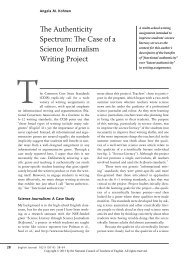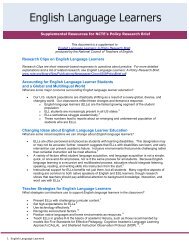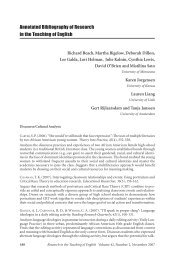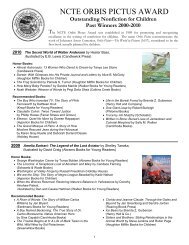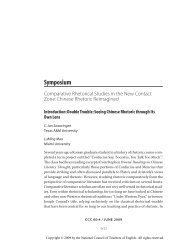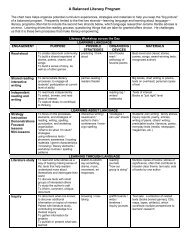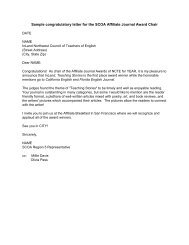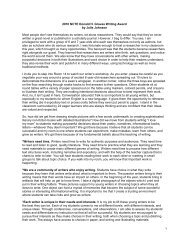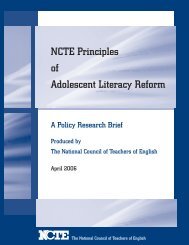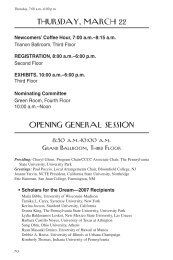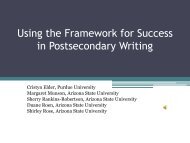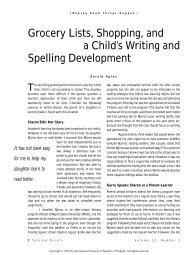Annotated Bibliography of Research in the Teaching of English
Annotated Bibliography of Research in the Teaching of English
Annotated Bibliography of Research in the Teaching of English
- No tags were found...
Create successful ePaper yourself
Turn your PDF publications into a flip-book with our unique Google optimized e-Paper software.
218 <strong>Research</strong> <strong>in</strong> <strong>the</strong> Teach<strong>in</strong>g <strong>of</strong> <strong>English</strong> Volume 41 November 2006STALLWORTH, B., GIBBONS, L., & FAUBER, L. (2006). It’s not on <strong>the</strong> list: An exploration <strong>of</strong> teachers’perspectives on us<strong>in</strong>g multicultural literature. Journal <strong>of</strong> Adolescent & Adult Literacy, 49(6), 478–489.Exam<strong>in</strong>es which book-length works were taught most frequently <strong>in</strong> Alabama high school <strong>English</strong>language arts classrooms <strong>in</strong> order to exam<strong>in</strong>e <strong>in</strong>tegration <strong>of</strong> multicultural texts. F<strong>in</strong>ds thatcommon lists <strong>of</strong> selections tended to have a Eurocentric and patriarchic bias, but that a widevariety <strong>of</strong> books are taught, and that what teachers consider “classics” do not necessarily reflect<strong>the</strong> traditional canon. Suggests that lack <strong>of</strong> resources, concerns about censorship, time constra<strong>in</strong>ts,and lack <strong>of</strong> knowledge about multicultural literature affect teachers’ decisions to teachmulticultural literature <strong>in</strong> <strong>the</strong> classroom.STONE, J. C. (2005). Textual borderlands: Students’ recontextualizations <strong>in</strong> writ<strong>in</strong>g children’sbooks. Language Arts, 83(1), 42-51.Analyzes 12 female middle-school students’ children’s book writ<strong>in</strong>g <strong>in</strong> terms <strong>of</strong>“recontextualizations” <strong>of</strong> sett<strong>in</strong>gs, characters, language, and popular culture <strong>in</strong> ways that mediatebetween <strong>the</strong>ir community and school cultures. F<strong>in</strong>ds that students create characters <strong>of</strong> colorto address <strong>the</strong> lack <strong>of</strong> such characters <strong>in</strong> <strong>the</strong>ir school read<strong>in</strong>g, African American Vernacular<strong>English</strong> for use <strong>in</strong> dialogue, popular culture artifacts, and music <strong>in</strong> construct<strong>in</strong>g characters’appearance and practices. Suggests <strong>the</strong> value <strong>of</strong> us<strong>in</strong>g writ<strong>in</strong>g <strong>of</strong> children’s books to foster criticalliteracies.SUMARA, D., DAVIS, B., & IFTODY, T. (2006). Normaliz<strong>in</strong>g literary responses <strong>in</strong> <strong>the</strong> teacher educationclassroom. Chang<strong>in</strong>g <strong>English</strong>, 13(1), 55-67.Analyzes preservice <strong>English</strong> teachers’ responses to a young adult novel portray<strong>in</strong>g challenges tonormative sexual stereotypes. Draws on consciousness <strong>the</strong>ory to exam<strong>in</strong>e how participants’responses reflect tensions between <strong>the</strong> normative discourses related to sexuality operat<strong>in</strong>g <strong>in</strong>teacher education programs and methods courses versus <strong>the</strong> need to <strong>in</strong>terrogate those normativediscourses. Develops <strong>the</strong>ories on how preservice <strong>English</strong> teachers’ conscious awareness <strong>of</strong><strong>the</strong>ir own identities evolved dur<strong>in</strong>g <strong>the</strong>ir teacher education programs.SUTHERLAND, L. M. (2005). Black adolescent girls’ use <strong>of</strong> literacy practices to negotiate boundaries<strong>of</strong> ascribed identity. Journal <strong>of</strong> Literacy <strong>Research</strong>, 37(3), 365-406.Follows six 16-year-old Black girls as <strong>the</strong>y studied Morrison’s The Bluest Eye <strong>in</strong> <strong>the</strong>ir high school<strong>English</strong> class. F<strong>in</strong>ds that <strong>the</strong>se girls used <strong>the</strong>ir read<strong>in</strong>g <strong>of</strong> <strong>the</strong> novel to explore <strong>the</strong>ir own lifeexperiences ra<strong>the</strong>r than to explore <strong>the</strong> story itself. As <strong>the</strong>y did so, <strong>the</strong>y exam<strong>in</strong>ed <strong>the</strong> forces thatcreated boundaries <strong>in</strong> <strong>the</strong>ir own lives, challenged <strong>the</strong>se boundaries, and worked toge<strong>the</strong>r toconstruct <strong>the</strong>ir identities as young Black women.VERBOORD, M. (2005). Long-term effects <strong>of</strong> literary education on book-read<strong>in</strong>g frequency: Ananalysis <strong>of</strong> Dutch student cohorts 1975-1998. Poetics, 33(5-6), 320-342.Investigates <strong>the</strong> <strong>in</strong>fluence <strong>of</strong> teacher- versus student-centered approaches to literary educationon students’ book-read<strong>in</strong>g frequency later <strong>in</strong> life. Eighty-five mo<strong>the</strong>r-tongue teachers <strong>in</strong> Dutchsecondary education were retrospectively questioned about <strong>the</strong>ir literature <strong>in</strong>struction <strong>in</strong> a randomyear between 1975 and 1998. About 700 former students <strong>of</strong> <strong>the</strong>se teachers were <strong>in</strong>terviewedabout <strong>the</strong>ir current read<strong>in</strong>g frequency. F<strong>in</strong>ds that a student-centered approach to literatureteach<strong>in</strong>g is associated with higher book-read<strong>in</strong>g frequency, while a teacher-centered approachis associated with lower book-read<strong>in</strong>g frequency <strong>in</strong> later life.WARREN, J. E. (2006). Literary scholars process<strong>in</strong>g poetry and construct<strong>in</strong>g arguments. WrittenCommunication, 23(2), 202-226.Investigates <strong>the</strong> read<strong>in</strong>g-to-write processes <strong>of</strong> literary scholars. Focuses on <strong>the</strong> special “topoi” or



